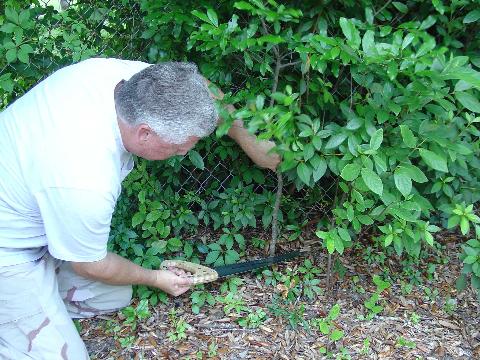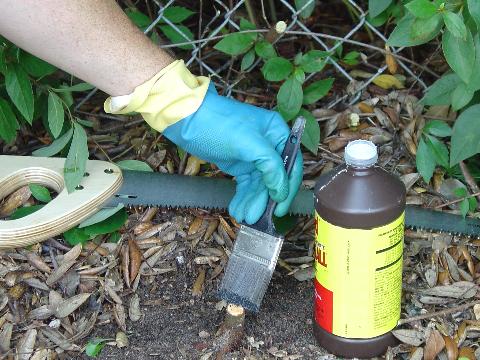
Making cut before herbicide application Photo Credits: Larry Williams & Sheila Dunning, Okaloosa County Extension Agents
Question: We planted Wisteria for its beautiful spring flowers and it grew and grew and took over everything. Now we’re trying to get rid of it. New plants are sprouting everywhere – up to ten feet away from the original plant. Is there a way to rid our landscape of this now wild plant?
Answer: Chinese Wisteria, Wisteria sinensis, can be a big problem to control. I’ve seen entire fields taken over by it. Yet, many people wonder why you would want to kill a beautiful plant like Wisteria. It’s possible to keep it in bounds for a while (possibly years) in the middle of a lawn with its new shoots arising from roots being routinely mowed. But in many cases, given enough time, shoots coming from roots will escape and then begin to take over – growing on adjacent property, climbing trees, etc.

Application of triclopyr herbicide to cut stump Photo Credits: Larry Williams & Sheila Dunning, Okaloosa County Extension Agents
In order to control an established vine, you must be persistent. Your best bet, outside of moving, is to use a “cut stump” treatment on the main plant and every shoot that sprouts. Use a herbicide that contains triclopyr. Some brand names include Enforcer Brush Killer, Ortho Brush-B-Gon, Ferti-lome Brush Killer-Stump Killer. Cut the main stem (trunk) as close to the ground as possible and as level as possible to facilitate application of the herbicide to prevent sprouting. It is critical to immediately apply the product to the freshly cut “stump.” Stumps that are not treated with the herbicide will sprout. Always follow label directions and precautions and be very careful to not get the product on adjacent desirable plants, including their roots.
Other invasive, undesirable woody plants can be controlled using this method such as Chinese tallow (popcorn tree), Chinese privet (Ligustrum sinensis) and Japanese honeysuckle (Lonicera japonica). For more information, view “Herbicide Techniques for Woody Plant Control”, from UF IFAS Extension .
- Summer is Too Hot for Lawn Herbicides - August 23, 2025
- Nuisance Gnats abound in Northwest Florida this spring - June 26, 2025
- Watering to Establish a New Lawn - May 15, 2025
